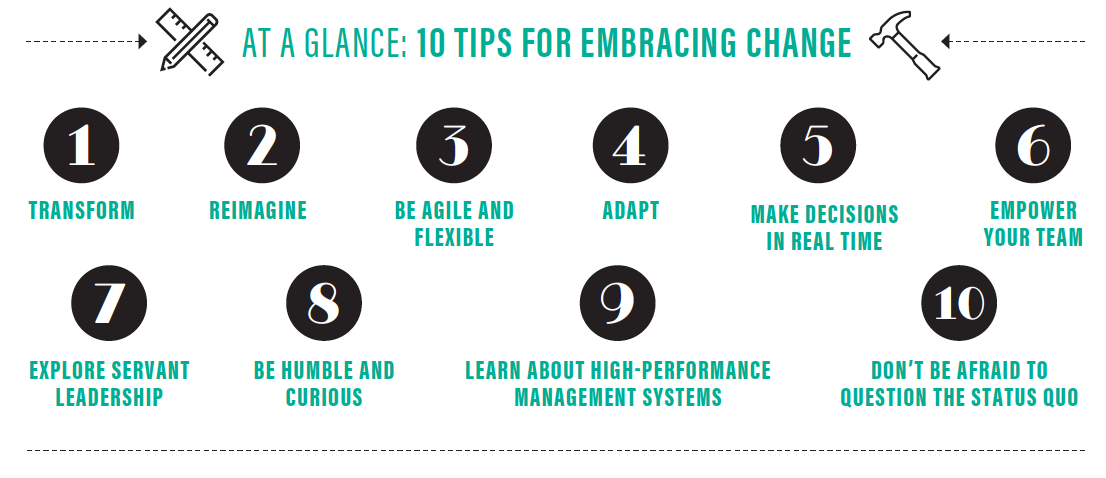
From technology and social media to the regulatory and medicolegal environment, ophthalmology is in a period of great and fast-moving change. We can’t control what is changing or how fast it’s coming, but we can choose how to respond to it. Leaders who are agile can take advantage of this changing environment to strengthen themselves and their organizations, but it takes courage and openness. The following 10 tips tell a story of how a leader can embrace change and move forward successfully.
No. 1: Transform
If you’re leading an organization, you need to think ahead of the curve, anticipate where things are going, and think about how to engage effectively. To transform, you need to be open to experiment. Just because you’ve led in a certain way in the past doesn’t mean that it’s going to work as well in the future. One of the biggest challenges in a rapidly changing environment is information overload; there’s so much coming at you. It may be useful to identify experts who can be advisors to you or can give you some better insights. Thinking ahead of the curve and being open to experimenting helps you to be more flexible.
No. 2: Reimagine
Reimagining is shifting your mindset to start asking your organization and yourself some questions. What if we did it this way? How about this approach? As a leader, it means asking about the collective experience. If you can reimagine a situation, a problem, or an opportunity and start asking questions to better understand what potential approaches you could take, it opens you up to a fuller exploration of what you might do.
No. 3: Be agile and flexible
When you focus on a goal—whether it’s growing a practice, incorporating a new procedure, or bringing on new millennial employees—you need to accept that there are different paths to get there and that employees have different understandings and approaches. As a senior leader, you don’t need to understand an issue to the same level of detail that, say, a millennial employee does, but you can rely on his or her expertise and empower that individual to solve problems and create opportunities.
No. 4: Adapt
There’s so much information coming in all the time that it’s like drinking from a fire hose. You need to be able to identify what trends are most pertinent to your day-to-day business and strategically determine what you need to pay attention to.
A few years ago, when interest in social media was really starting to grow, I went to a digital marketing course. It was an all-day event, and speakers from Google, Instagram, and other tech companies were there. They were living and breathing social media every single day, and I was trying to understand it and see how it applied to what I was doing. The ability to adapt and look for key insights is important to being able to lead in a changing environment.
No. 5: Make decisions in real time
Leaders rarely have the luxury of having a long time to get perfect information about a situation. You can’t afford to be too long in your deliberation because you may miss the opportunity or be unable to offset something that’s coming at you negatively. Sometimes you have to make decisions in real time. The decision process is not always perfect, but you have to be able to effectively draw the team together, get the input you need, make sure that you’re as informed as you can be, and then go.

No. 6: Empower your team
Leaders don’t have to know everything and don’t have to make all the decisions, but they need to be okay with hiring sharp, capable people and then empowering those people to make decisions. I believe it’s better to err on the side of action than to get into analysis-paralysis mode, which stops you from being able to lead in a changing environment. Think about who has the best information to make a decision, and let those people act swiftly. Leaders must accept—and let employees know—that a project is not always going to work out exactly the way it was planned.
No. 7: Explore servant leadership
Servant leadership is the way of the future. This is an approach that places the focus on serving others first. Robert K. Greenleaf, the founder of the concept, explained: “It begins with the natural feeling that one wants to serve, to serve first. Then conscious choice brings one to aspire to lead. That person is sharply different from one who is leader first. ... The difference manifests itself in the care taken by the servant-first to make sure that other people’s highest priority needs are being served.”1
If you’re serving your employees, serving your customers, and serving the natural environment, you’re probably in a better position to have a successful outcome than if you’re trying to be directive and control it. It is a false sense of security to think you can control the environment that you’re in.
No. 8: Be humble and curious
No leader can know everything, but you hold the North Star. You hold the bigger directions, and you need to be able to ask questions that move the organization forward. We all have our own biases, experiences, and ways of approaching things. Having humility and curiosity lets you and your team know that you don’t know (and shouldn’t have to know) everything, but that you trust your capable team to help you navigate effectively.
Also, remember that people can only do what they can do, and they can only take in as much as they can take in. Accept that, and always keep a sense of humor—the best stress reliever.
No. 9: Learn about high-performance management systems
Some organizations have great success with high-performance management systems. The basic concept is that you try to align the organization to focus on a few vital projects, programs, or issues that you can make an impact with. Whether you have a team of five or 5,000, in a changing environment you can’t—and shouldn’t—do everything. Reduce the undertakings that don’t create momentum so that you can focus on those that will make a difference for the patients you serve, the people on your team, and the industry you participate in.
No. 10: Don’t be afraid to question the status quo
Just because something worked in the past doesn’t mean it’s the right approach for the future; I call it taking more ground. You can move things forward much more readily if you’re not just sticking with the status quo and saying, “We’ve already done it this way,” but rather asking, “How could we do that? What else could we do? What else should we think about? Are there other things that we’re not considering in this decision?”
One of the biggest advantages of working in diverse teams is that everybody brings his or her own point of view and knowledge to the discussion. If you have a team that is diverse culturally, age-wise, and gender-wise, you can make better informed decisions in a changing environment.
CONCLUSION
Practices can be overwhelmed by change. You can either embrace it or fight it. Only one of those options has a happy ending.
Embracing change gives you a sense of participation and engagement rather than a feeling that something is happening to you. When people think something is happening to them, their anxiety, stress, and protective walls go up. That negative energy doesn’t help you or your team. If your team sees that you’re resistant and stressed, every person on the team will feel that way, too.
If you are being a servant leader and trying to serve both your team and your organization, you can step back and say: “We’re going to work together to understand how to best navigate this. Every week at our staff meeting, we’re going to talk about how to transform our practice to be one of the best in the community. Nothing is outside the realm of possibility. Let’s talk.”
This opens a broader way of looking at things, and your team (especially millennials) will come up with great ideas that you might not have thought would be part of a medical practice. They will challenge the way you’ve been doing things, and together, you, your team, and your organization will grow in ways you’ve never imagined.
1. The Servant as Leader. Robert K. Greenleaf Center for Servant Leadership. https://www.greenleaf.org/what-is-servant-leadership/. Accessed May 3, 2018.




